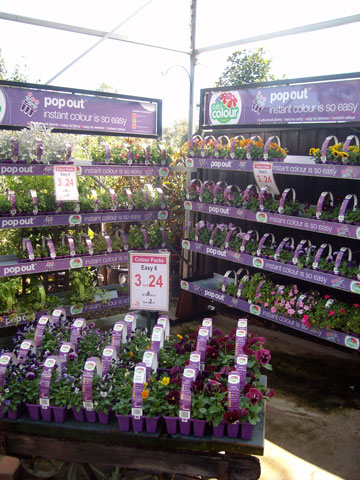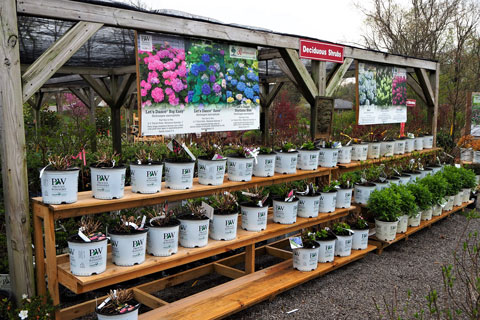10/1/2021
Communicating the Benefits of New Varieties
Maria Zampini

When it comes to new plant varieties, there are soooo many it can be overwhelming and hard to keep up with them all. And that’s how you or I, who work in the green industry, may feel. Just think how the home gardeners’ heads must spin!
Let me ask you—how did you learn about a new plant and what made you decide to invest in bringing it in to your store? Now, how do you take all or part of that information that made you say “yes to the plant” and communicate it to your customer?
Regardless of whether “new” means a new plant just coming on the market, a plant that’s not brand new, but it’s the first time you’re offering it for sale, or an underused or overlooked plant (you know this one; a really cool plant with a name absolutely no one can pronounce, let alone remember). Whichever scenario is pertinent to your retail situation, they all are new in some way, shape or form and they won’t fly off the shelves on their own. Some will naturally sell faster than others (think in flower), but taking the time to market new plants will help them fly out the door like a fast car and not a horse-drawn carriage.
Getting the Fundamentals Right
Having run my family’s destination attraction garden center and visited IGCs across the country for years, I’ve seen some of the best retail marketing here and abroad. I think it still boils down to actually doing the basics and doing them right.
If you’re an owner or in retail management, park your ego at the door. You can’t do everything. Empower those around you, especially those passionate about plants, new or not, to help your business communicate better. Do what you do best, but let the reins out for others in your company to do what they do best.
Seeing is believing; educate and inspire:
• Create a landscape display garden where customers can see what plants do naturally.
• Create a trial bed or container where you can show a comparison between a new plant and other selections so customers can see the difference.
• Don’t have enough room to build a landscape or trial area? Look at where you might put in a temporary or “faux” landscape that you can change out depending on what’s “looking good” just by lining up pots in front of your store. Or you can enclose an area with timbers so it looks like more than just a row of pots. You could also fill the area with mulch and drop in containers for a more finished feel.
Make memorable, eye-catching, FOMO displays.
• Display a new plant by itself. It sounds simple, but make it a focal point. And I’m not necessarily talking about a display in the nursery area, either. Create a display right outside the front door. Or put it in a display right as they walk inside. And not some dinky display either. As my dad would say, “You can’t sell from an empty cart.”
• Consider an endcap at the checkout for impulse purchases. Don’t just put gloves or Scotts Miracle-Gro in that space. If you’ve got a new plant in bloom, hit them in the face with it!
• Create small vignettes that inspire customers on how a new plant might look at their home. Be it with a front door prop or with outdoor furniture, in a deco container, etc. … people need to envision it in their own space.
• Dr. Allan Armitage talks about “solution gardening.” If the new introduction attracts and feeds the birds, make sure your display screams “buy me if you want to feed the birds naturally.”
Use The Tools Available
Facts tell, benefits sell.
With any new plant make sure they’re tagged (most tags mainly have facts) and there’s signage that, at the bare minimum, lists the name, benefits and says NEW! Also include how it may match a consumer’s wants and/or needs. If feeding the bees are a new plant’s super power, then the display and signage needs to convey that at a glance.
Houseplants and succulents are “it plants,” yet many come with generic tags that only say houseplant or succulent (a crime against horticulture if ever there was one). Make your own tags or signage to provide the name, basic info and benefits because who wants to buy a nameless plant and be given no information at all about it? Not me.
Branded programs really do the heavy marketing lifting for you.
If your new plant is from a branded program, they likely have a wealth of information, signage, POP and much more that’s simply there for the taking. I still have visions of POP piled up in a corner that I didn’t utilize at my store; I was “too busy.” I can look back on that and think I was really “too silly” and forfeited sales that these information pieces might have made for me. Shame on me (and you) if you don’t utilize these things.
And as a branded program points out, new varieties have improvements over others on the market. Know that breeders are continually working toward creating plants that address cultural needs, such as water wise, non-invasive and disease/pest-resistant
cultivars.
More Opportunities
Trialing.
If you or your staff trial plants in your home gardens, you can then talk intelligently and with personal experience about what works well to your customers in your geographic area; that level of expertise is invaluable in sales.
Social media.
When I give talks about social media, I say consistency is key and pick one platform, do it right and then add more. There’s
no sense in being on four social media
platforms and doing them all poorly. Specifically, here’s where you find someone in your organization who can manage social media for you.
While you need to make your own content for new plants, breeders, breeder representatives and/or brands have lots of informational content (pictures, posts, articles, etc.) that you can share!
 Connect with and establish relationships with local arboretums, botanical gardens, garden writers, master gardeners, gardening groups and any other plant geeks in your area. They, too, have content on new plants, but more importantly, these plant people can be tagged in your social posts and will help like and spread the word. The local Cleveland ABC weatherman is a dedicated gardener, so I’m always tagging him on Twitter. It doesn’t hurt when he uses your photo as the background on his weather forecast!
Connect with and establish relationships with local arboretums, botanical gardens, garden writers, master gardeners, gardening groups and any other plant geeks in your area. They, too, have content on new plants, but more importantly, these plant people can be tagged in your social posts and will help like and spread the word. The local Cleveland ABC weatherman is a dedicated gardener, so I’m always tagging him on Twitter. It doesn’t hurt when he uses your photo as the background on his weather forecast!
More digital opportunities.
Other digital forms of communication, such as an e-news or website, need to be up to date and showcase that you’re THE place for new plants. And not just “buy me” messages, but posts discussing plants with benefits. For instance, a boxwood alternative that’s immune to blight (Gem Box), a non-invasive butterfly bush (The Lo & Behold Buddleia series), or practical plant uses like choosing a native, low-growing groundcover plant like Ground Hug Aronia for ground stabilization in sloped gardens. Think, “What’s the issue I want to solve for my customer?” and there’s probably a new variety that addresses it.
As you can see, not everything needs to be new when it comes to marketing new plants. Go back to the basics, keep it simple and do it right the first time. GP
Maria Zampini is the owner of UpShoot LLC, a boutique horticultural marketing firm specializing in new plant introductions and gardening-related products. She writes for consumer magazines and horticultural trade journals, and is the co-author of “Garden-pedia: An A-Z Guide to Gardening Terms.” She can be reached at maria@upshoothort.com.